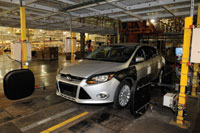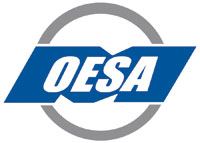 |
| Michigan Assembly Plant. Photo courtesy of Ford Motor Company |
Overall, the state of the North American automotive industry is good – that is, relative to the production levels, financial strength, employment plans and capital investment. Without a doubt, the recent earthquake, tsunami and nuclear power plant crisis in Japan is presenting a significant, short-term headwind for the North American automotive industry. The global industry is proving that it is able to respond to a crisis and adapt quickly to protect vehicle sales and production. This article covers a variety of short-term and long-term issues facing the North American automotive supplier industry.
The Japan Crisis
The human tragedy and economic impact of the March 11, 2011, Japanese earthquake, tsunami and nuclear power plant crisis will be with the Japanese people for years to come. The complexity and integration of the global supply chain came into clear focus as over 500 automotive-related plants were damaged or destroyed. In Japan, sales and production volumes will not be recovered in 2011; in fact some volume will not be recovered until well into 2012. For North America, it appears that lost production will likely be held below 250,000 units for 2011 and could be fully restored through the first quarter of 2012. Toyota, Honda and Nissan have announced major reductions in their production schedules through the first half of the year. GM, Ford, Chrysler and the other North American vehicle producers are “flexing” their systems – taking out scheduled overtime, reducing line rates, or, in only the worst-case scenarios, taking a full plant down from a day to a week at a time. These units will come back into the schedules as part supplies are secured down through the value chain.
In the short-term, within two months, production may be reallocated to North American assembly plants and suppliers that have product quality validation to support global platforms. However, this should be viewed as “swing capacity” that will move back to Japan or other regions as the supply base is restored. Resourcing in the mid-term (the next two to three months) may occur in North America where vehicle manufacturers believe the time and costs to validate a second source is required to protect supply chains.
Longer-term, the recent crisis, plus the transportation interruptions caused by volcano eruptions, hurricanes, port worker strikes and the like will re-focus vehicle manufacturers and system integrator suppliers to assure best cost, but also the best, lowest risk strategy to protect the supply of components into the assembly plants. This is not to say that the industry will abandon global souring. A global supply base will support this global vehicle industry. However, the industry will look for better visibility down through the entire value chain, including materials, so that there will not be undo risk by sole sourcing critical components or materials from a single plant in a high risk region. The results should be greater investment in all the major vehicle regions in the world. There will be a regional balance between the share of global vehicle sales, vehicle assembly and component production.
The General Situation
The March 11th Japanese tragedy only exacerbated material shortages that were prevalent through the industry. Shortages of electronic components, specialty alloy steels, bearings, tires and other components were putting the 2011 North America production forecast of 12.8 to 13.1 million units at risk. The March 2011 OESA Automotive Supplier Barometer (taken the week before the Japan earthquake) indicated that the supply base was dealing with major issues including:
Material cost premiums
Expedited freight
Short shipments
Production labor premiums
Inventory carrying costs
However, even with these challenges, the OESA Automotive Supplier Sentiment Index, an index that measures suppliers’ change in their 12-month business outlook, stood at 66 in March and has been tracking in an optimistic direction since May 2010. The month-to-month pattern in confidence has been somewhat erratic as suppliers’ confidence rises as they become more confident with production releases and sales levels. However, increasing oil prices and continuing conflicts in the Middle East erode that confidence.
The Financial Situation
Overall, the financial situation of the supply base has improved tremendously during the past two years as suppliers have benefited from a rebound in vehicle production schedules and have significantly restructured cost and balance sheets. In fact, only 10 percent of the OESA membership base report issues with their general working capital levels. Based on survey work OESA did in January 2011, a representative section of the suppliers noted 2011 North American planning volumes were pegged at 12.5 million units (on average) while North American breakeven levels stood at 10.5 million units (on average). This provides encouragement that North American suppliers will remain relatively financially stable throughout the current crisis. However, with this said, depending on their customer base, the crisis without a doubt will affect some suppliers more severely than others. In addition, smaller suppliers continue to face financing challenges. Although the situation is vastly improved from the economic crisis of 2009, capital to re-tool for new production programs continues to be an issue.
Geographic Footprint
The 2009 economic crisis did force many major supplier firms into restructuring in and out of bankruptcy court. OESA identified 62 major supplier bankruptcies during 2009. Since then, approximately one-third of these firms reemerged, restructured from Chapter 11. Approximately one-third were liquidated or acquired into other firms. The remaining firms are still operating under protection or simply failed without being able to be tracked. Work by Jim Rubenstien, Miami University, and Thomas Kleir, Federal Reserve Bank of Chicago, identified that approximately 7 percent of the U.S. automotive supplier plants had permanently closed between 2006 and 2009. In their analysis, they identified that 51 percent of these plant closures occurred in the Midwest and 15 percent occurred in Southern states. The remainder was spread throughout the United States. It appears the North American geographic footprint is being squeezed into the center (or more precisely along the I-75 corridor) and stretched, North-South from Canada and into Mexico.
The HR Situation
The industry restarted its hiring in a significant manner at the back end of 2009 to support production generated by the “Cash for Clunkers” program. U.S. supplier industry employment reached a low in June/July 2009 at slightly below 400,000 persons. U.S. supplier employment reached 430,000 people in February 2011. There continues to be a “mismatch” between industry requirements and available talent. At the beginning of the year, 56 percent of OESA members reported a shortage of skilled labor and almost 30 percent noted a shortage of production workers. Without a doubt, the industry will be very cautious in hiring back employees – salary and hourly.
 OESA
OESA
OESA provides a voice, forum and resource base for the North American supply base. With nearly 400 members, OESA is the primary advocate for light-duty vehicle suppliers on commercial and public policy issues. The Association is addressing the issues mentioned above and many others through town hall events, benchmarking surveys and peer group councils. Members have the support of a fourteen member staff in Troy, Mich. And, as a market sector association of the Motor & Equipment Manufacturers Association, has an additional nine persons in Washington, D.C. OESA membership is open to any component supplier with operations in North America, international suppliers with NAFTA sales and firms providing services to North American based firms. Complete information is found at www.oesa.org.

